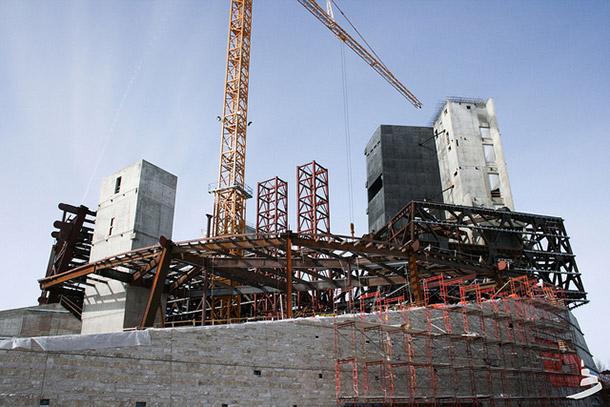Building the Museum

The Making of an International Landmark
The new home of the Canadian Museum for Human Rights is more than a building. It’s a concrete symbol of ideas that are important to Canadians. The building’s very location and design tell us a story of human rights in Canada. They inspire us to be proud of the past and hopeful for the future.
The Making of a Great Building
The dream The date was April 17, 2003. It was the anniversary of the signing of the Canadian Charter of Rights and Freedoms (1982). Business leader Izzy Asper, founder of Canwest, brought forward the idea of a Canadian museum of human rights. He saw it as a place where students could learn about human rights. He also wanted to bring new life to central Winnipeg and attract visitors from Canada and the world. He died later that year, but his daughter Gail Asper continued the cause.
The architect
In 2003, the Friends of the Canadian Museum for Human Rights launched one of Canada’s largest international architectural competitions. Entries came from 64 countries. The winner was an American architect, Antoine Predock.
The partners
In 2008, three levels of government came together with the private sector to build a great museum. The governments of Canada, Manitoba and Winnipeg joined with the Forks North Portage Partnership and the Friends of the Canadian Museum for Human Rights to begin the $351 million project.
The legislation
On March 13, 2008, the Government of Canada passed Bill C-42 into law. The bill changed the National Museums Act to include the first new national museum in nearly half a century.
The research
The Museum went to Canadians to ask for their ideas. People said they wanted the Museum to talk about human rights victories in Canada and the world, today’s debates about human rights, and events that showed Canada’s commitment to human rights, as well as its failures.
The land
A site was identified. The Museum would stand on Treaty One territory, not far from the place where the Métis rebelled under Louis Riel in 1870. Treaty One was Canada’s first treaty after Confederation. It was signed in 1871 and covered the relationship between Canada and the First Nations in Manitoba. Archeologists dug into the land here before construction began and found more than half a million objects that tell the story of this site.
The building
On December 19, 2008, there was a ground-breaking ceremony at The Forks in Winnipeg. Construction began in April 2009.
Base Building – Most of the work on the building itself was complete in March 2013.
Glass Envelope – The last of 1,669 custom-cut pieces of glass was installed in September 2013.
Opening the doors
The Museum held opening ceremonies on September 19, 2014 and began welcoming visitors on September 20, 2014.










